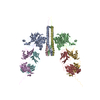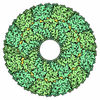[English] 日本語
 Yorodumi
Yorodumi- PDB-8xc4: Nipah virus attachment glycoprotein head domain in complex with a... -
+ Open data
Open data
- Basic information
Basic information
| Entry | Database: PDB / ID: 8xc4 | ||||||
|---|---|---|---|---|---|---|---|
| Title | Nipah virus attachment glycoprotein head domain in complex with a broadly neutralizing antibody 1E5 | ||||||
 Components Components |
| ||||||
 Keywords Keywords | ANTIVIRAL PROTEIN/IMMUNE SYSTEM / Henipavirus / Glycoprotein / Head domain / Antibody / ANTIVIRAL PROTEIN / ANTIVIRAL PROTEIN-IMMUNE SYSTEM complex | ||||||
| Function / homology |  Function and homology information Function and homology informationexo-alpha-sialidase activity / host cell surface receptor binding / viral envelope / symbiont entry into host cell / virion attachment to host cell / host cell plasma membrane / virion membrane / plasma membrane Similarity search - Function | ||||||
| Biological species |  Henipavirus nipahense Henipavirus nipahense | ||||||
| Method |  X-RAY DIFFRACTION / X-RAY DIFFRACTION /  SYNCHROTRON / SYNCHROTRON /  MOLECULAR REPLACEMENT / Resolution: 3.24 Å MOLECULAR REPLACEMENT / Resolution: 3.24 Å | ||||||
 Authors Authors | Fan, P.F. / Yu, C.M. / Chen, W. | ||||||
| Funding support |  China, 1items China, 1items
| ||||||
 Citation Citation |  Journal: Nat Commun / Year: 2024 Journal: Nat Commun / Year: 2024Title: A potent Henipavirus cross-neutralizing antibody reveals a dynamic fusion-triggering pattern of the G-tetramer. Authors: Pengfei Fan / Mengmeng Sun / Xinghai Zhang / Huajun Zhang / Yujiao Liu / Yanfeng Yao / Ming Li / Ting Fang / Bingjie Sun / Zhengshan Chen / Xiangyang Chi / Li Chen / Cheng Peng / Zhen Chen / ...Authors: Pengfei Fan / Mengmeng Sun / Xinghai Zhang / Huajun Zhang / Yujiao Liu / Yanfeng Yao / Ming Li / Ting Fang / Bingjie Sun / Zhengshan Chen / Xiangyang Chi / Li Chen / Cheng Peng / Zhen Chen / Guanying Zhang / Yi Ren / Zixuan Liu / Yaohui Li / Jianmin Li / Entao Li / Wuxiang Guan / Shanshan Li / Rui Gong / Kaiming Zhang / Changming Yu / Sandra Chiu /  Abstract: The Hendra and Nipah viruses (HNVs) are highly pathogenic pathogens without approved interventions for human use. In addition, the interaction pattern between the attachment (G) and fusion (F) ...The Hendra and Nipah viruses (HNVs) are highly pathogenic pathogens without approved interventions for human use. In addition, the interaction pattern between the attachment (G) and fusion (F) glycoproteins required for virus entry remains unclear. Here, we isolate a panel of Macaca-derived G-specific antibodies that cross-neutralize HNVs via multiple mechanisms. The most potent antibody, 1E5, confers adequate protection against the Nipah virus challenge in female hamsters. Crystallography demonstrates that 1E5 has a highly similar binding pattern to the receptor. In cryo-electron microscopy studies, the tendency of 1E5 to bind to the upper or lower heads results in two distinct quaternary structures of G. Furthermore, we identify the extended outer loop β1S2-β1S3 of G and two pockets on the apical region of fusion (F) glycoprotein as the essential sites for G-F interactions. This work highlights promising drug candidates against HNVs and contributes deeper insights into the viruses. | ||||||
| History |
|
- Structure visualization
Structure visualization
| Structure viewer | Molecule:  Molmil Molmil Jmol/JSmol Jmol/JSmol |
|---|
- Downloads & links
Downloads & links
- Download
Download
| PDBx/mmCIF format |  8xc4.cif.gz 8xc4.cif.gz | 699.5 KB | Display |  PDBx/mmCIF format PDBx/mmCIF format |
|---|---|---|---|---|
| PDB format |  pdb8xc4.ent.gz pdb8xc4.ent.gz | 585 KB | Display |  PDB format PDB format |
| PDBx/mmJSON format |  8xc4.json.gz 8xc4.json.gz | Tree view |  PDBx/mmJSON format PDBx/mmJSON format | |
| Others |  Other downloads Other downloads |
-Validation report
| Summary document |  8xc4_validation.pdf.gz 8xc4_validation.pdf.gz | 2.6 MB | Display |  wwPDB validaton report wwPDB validaton report |
|---|---|---|---|---|
| Full document |  8xc4_full_validation.pdf.gz 8xc4_full_validation.pdf.gz | 2.6 MB | Display | |
| Data in XML |  8xc4_validation.xml.gz 8xc4_validation.xml.gz | 63.4 KB | Display | |
| Data in CIF |  8xc4_validation.cif.gz 8xc4_validation.cif.gz | 85.6 KB | Display | |
| Arichive directory |  https://data.pdbj.org/pub/pdb/validation_reports/xc/8xc4 https://data.pdbj.org/pub/pdb/validation_reports/xc/8xc4 ftp://data.pdbj.org/pub/pdb/validation_reports/xc/8xc4 ftp://data.pdbj.org/pub/pdb/validation_reports/xc/8xc4 | HTTPS FTP |
-Related structure data
| Related structure data |  8k0cC  8k0dC  6vy5S S: Starting model for refinement C: citing same article ( |
|---|---|
| Similar structure data | Similarity search - Function & homology  F&H Search F&H Search |
- Links
Links
- Assembly
Assembly
| Deposited unit | 
| ||||||||
|---|---|---|---|---|---|---|---|---|---|
| 1 | 
| ||||||||
| 2 | 
| ||||||||
| Unit cell |
|
- Components
Components
-Protein , 1 types, 2 molecules AB
| #1: Protein | Mass: 49310.734 Da / Num. of mol.: 2 Source method: isolated from a genetically manipulated source Source: (gene. exp.)  Henipavirus nipahense / Cell line (production host): Expi293F / Production host: Henipavirus nipahense / Cell line (production host): Expi293F / Production host:  Homo sapiens (human) / References: UniProt: Q4VCP5 Homo sapiens (human) / References: UniProt: Q4VCP5 |
|---|
-Antibody , 2 types, 4 molecules CEDF
| #2: Antibody | Mass: 26120.047 Da / Num. of mol.: 2 Source method: isolated from a genetically manipulated source Source: (gene. exp.)   Homo sapiens (human) Homo sapiens (human)#3: Antibody | Mass: 23235.764 Da / Num. of mol.: 2 Source method: isolated from a genetically manipulated source Source: (gene. exp.)   Homo sapiens (human) Homo sapiens (human) |
|---|
-Sugars , 5 types, 8 molecules 
| #4: Polysaccharide | beta-D-mannopyranose-(1-4)-2-acetamido-2-deoxy-beta-D-glucopyranose-(1-4)-[alpha-L-fucopyranose-(1- ...beta-D-mannopyranose-(1-4)-2-acetamido-2-deoxy-beta-D-glucopyranose-(1-4)-[alpha-L-fucopyranose-(1-6)]2-acetamido-2-deoxy-beta-D-glucopyranose | ||||||
|---|---|---|---|---|---|---|---|
| #5: Polysaccharide | | #6: Polysaccharide | #7: Polysaccharide | beta-D-mannopyranose-(1-4)-2-acetamido-2-deoxy-beta-D-glucopyranose-(1-4)-[alpha-L-fucopyranose-(1- ...beta-D-mannopyranose-(1-4)-2-acetamido-2-deoxy-beta-D-glucopyranose-(1-4)-[alpha-L-fucopyranose-(1-3)][alpha-L-fucopyranose-(1-6)]2-acetamido-2-deoxy-beta-D-glucopyranose | Type: oligosaccharide / Mass: 878.823 Da / Num. of mol.: 1 / Source method: obtained synthetically #8: Sugar | |
-Details
| Has ligand of interest | Y |
|---|---|
| Has protein modification | Y |
-Experimental details
-Experiment
| Experiment | Method:  X-RAY DIFFRACTION / Number of used crystals: 1 X-RAY DIFFRACTION / Number of used crystals: 1 |
|---|
- Sample preparation
Sample preparation
| Crystal | Density Matthews: 4.7 Å3/Da / Density % sol: 73.85 % |
|---|---|
| Crystal grow | Temperature: 289 K / Method: vapor diffusion, hanging drop Details: 1.5 M ammonium sulfate, 0.1 M sodium acetate trihydrate pH4.6 |
-Data collection
| Diffraction | Mean temperature: 100 K / Serial crystal experiment: N |
|---|---|
| Diffraction source | Source:  SYNCHROTRON / Site: SYNCHROTRON / Site:  SSRF SSRF  / Beamline: BL02U1 / Wavelength: 0.9789 Å / Beamline: BL02U1 / Wavelength: 0.9789 Å |
| Detector | Type: DECTRIS EIGER2 S 9M / Detector: PIXEL / Date: Sep 13, 2023 |
| Radiation | Protocol: SINGLE WAVELENGTH / Monochromatic (M) / Laue (L): M / Scattering type: x-ray |
| Radiation wavelength | Wavelength: 0.9789 Å / Relative weight: 1 |
| Reflection | Resolution: 3.24→50 Å / Num. obs: 58116 / % possible obs: 97.1 % / Redundancy: 6.4 % / Rmerge(I) obs: 0.189 / Net I/σ(I): 9.57 |
| Reflection shell | Resolution: 3.24→3.32 Å / Rmerge(I) obs: 0.189 / Num. unique obs: 58116 |
- Processing
Processing
| Software |
| |||||||||||||||||||||||||||||||||||||||||||||||||||||||||||||||||||||||||||||||||||||||||||||||||||||||||
|---|---|---|---|---|---|---|---|---|---|---|---|---|---|---|---|---|---|---|---|---|---|---|---|---|---|---|---|---|---|---|---|---|---|---|---|---|---|---|---|---|---|---|---|---|---|---|---|---|---|---|---|---|---|---|---|---|---|---|---|---|---|---|---|---|---|---|---|---|---|---|---|---|---|---|---|---|---|---|---|---|---|---|---|---|---|---|---|---|---|---|---|---|---|---|---|---|---|---|---|---|---|---|---|---|---|---|
| Refinement | Method to determine structure:  MOLECULAR REPLACEMENT MOLECULAR REPLACEMENTStarting model: 6VY5 Resolution: 3.24→33.69 Å / SU ML: 0.43 / Cross valid method: FREE R-VALUE / σ(F): 1.34 / Phase error: 25.22 / Stereochemistry target values: ML
| |||||||||||||||||||||||||||||||||||||||||||||||||||||||||||||||||||||||||||||||||||||||||||||||||||||||||
| Solvent computation | Shrinkage radii: 0.9 Å / VDW probe radii: 1.11 Å / Solvent model: FLAT BULK SOLVENT MODEL | |||||||||||||||||||||||||||||||||||||||||||||||||||||||||||||||||||||||||||||||||||||||||||||||||||||||||
| Refinement step | Cycle: LAST / Resolution: 3.24→33.69 Å
| |||||||||||||||||||||||||||||||||||||||||||||||||||||||||||||||||||||||||||||||||||||||||||||||||||||||||
| Refine LS restraints |
| |||||||||||||||||||||||||||||||||||||||||||||||||||||||||||||||||||||||||||||||||||||||||||||||||||||||||
| LS refinement shell |
| |||||||||||||||||||||||||||||||||||||||||||||||||||||||||||||||||||||||||||||||||||||||||||||||||||||||||
| Refinement TLS params. | Method: refined / Origin x: 59.5681 Å / Origin y: 27.1205 Å / Origin z: -24.4456 Å
| |||||||||||||||||||||||||||||||||||||||||||||||||||||||||||||||||||||||||||||||||||||||||||||||||||||||||
| Refinement TLS group | Selection details: all |
 Movie
Movie Controller
Controller




 PDBj
PDBj




